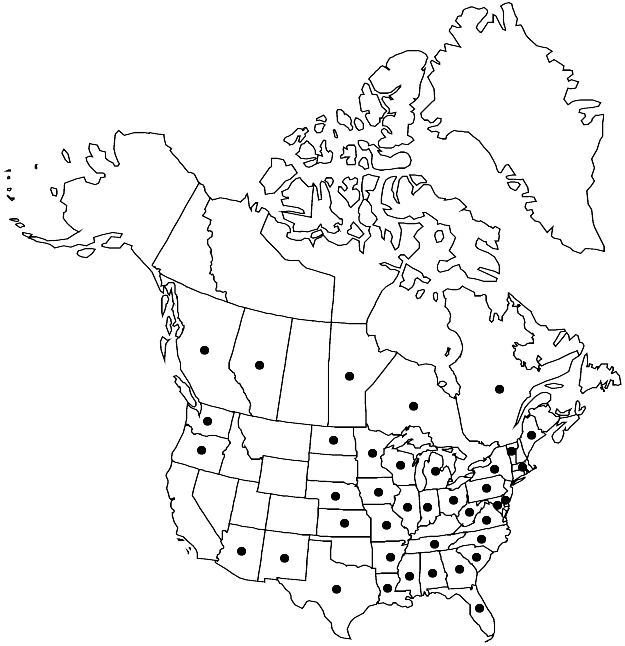Difference between revisions of "Haplocladium microphyllum"
in H. G. A. Engler and K. Prantl, Nat. Pfla n zenfam. 229[I,3]: 1007. 1907.
FNA>Volume Importer |
FNA>Volume Importer |
||
| Line 26: | Line 26: | ||
|elevation=low to high elevations (0-2500 m) | |elevation=low to high elevations (0-2500 m) | ||
|distribution=Alta.;B.C.;Man.;Ont.;Que.;Ala.;Ariz.;Ark.;Del.;Fla.;Ga.;Ill.;Ind.;Iowa;Kans.;La.;Maine;Md.;Mass.;Mich.;Minn.;Miss.;Mo.;Nebr.;N.Mex.;N.Y.;N.C.;N.Dak.;Ohio;Oreg.;Pa.;S.C.;Tenn.;Tex.;Vt.;Va.;Wash.;W.Va.;Wis.;Mexico;West Indies;South America;Eurasia. | |distribution=Alta.;B.C.;Man.;Ont.;Que.;Ala.;Ariz.;Ark.;Del.;Fla.;Ga.;Ill.;Ind.;Iowa;Kans.;La.;Maine;Md.;Mass.;Mich.;Minn.;Miss.;Mo.;Nebr.;N.Mex.;N.Y.;N.C.;N.Dak.;Ohio;Oreg.;Pa.;S.C.;Tenn.;Tex.;Vt.;Va.;Wash.;W.Va.;Wis.;Mexico;West Indies;South America;Eurasia. | ||
| − | |discussion=<p>Haplocladium microphyllum is the most commonly encountered species of the genus in North America, and is recognized by the frequently plicate base of the stem leaves, somewhat distant leaves when compared to the other species, and filamentous, little-branched paraphyllia that may be few and scattered or occasionally more common. Paraphyllia of H. angustifolium and H. virginianum are much more abundant, frequently branched and more commonly two or more rows of cells wide. The stem leaves of H. microphyllum are weakly decurrent with frequently flexuose acumina when dry; the branch leaves have short-rectangular, smooth, frequently reddish proximal laminal cells; and the capsules are 1.5–2 mm.</p> | + | |discussion=<p><i>Haplocladium microphyllum</i> is the most commonly encountered species of the genus in North America, and is recognized by the frequently plicate base of the stem leaves, somewhat distant leaves when compared to the other species, and filamentous, little-branched paraphyllia that may be few and scattered or occasionally more common. Paraphyllia of <i>H. angustifolium</i> and <i>H. virginianum</i> are much more abundant, frequently branched and more commonly two or more rows of cells wide. The stem leaves of <i>H. microphyllum</i> are weakly decurrent with frequently flexuose acumina when dry; the branch leaves have short-rectangular, smooth, frequently reddish proximal laminal cells; and the capsules are 1.5–2 mm.</p> |
|tables= | |tables= | ||
|references= | |references= | ||
| Line 50: | Line 50: | ||
|publication year=1907 | |publication year=1907 | ||
|special status= | |special status= | ||
| − | |source xml=https://jpend@bitbucket.org/aafc-mbb/fna-data-curation.git/src/ | + | |source xml=https://jpend@bitbucket.org/aafc-mbb/fna-data-curation.git/src/8f726806613d60c220dc4493de13607dd3150896/coarse_grained_fna_xml/V28/V28_536.xml |
|genus=Haplocladium | |genus=Haplocladium | ||
|species=Haplocladium microphyllum | |species=Haplocladium microphyllum | ||
Revision as of 17:06, 18 September 2019
Plants medium-sized. Stems somewhat irregularly pinnate; paraphyllia few, seldom many, filamentous, infrequently branched. Stem leaves erect, somewhat distant, broadly ovate to triangular, 2-plicate basally, 0.8–1.5 mm; margins plane, somewhat recurved basally, serrulate; costa ending in acumen or subpercurrent. Branch leaves somewhat distant, ovate, 0.5–0.7 mm; apex acute to acuminate; alar cells quadrate; medial laminal cells subquadrate, subrhombic, or very short-rectangular, smooth to 1-papillose over lumen or shifted distally, walls somewhat thick. Capsule inclined to horizontal. Spores 8–12 µm, essentially smooth.
Phenology: Capsules mature year-round.
Habitat: Damp wood, rock, humus, soil in woodlands
Elevation: low to high elevations (0-2500 m)
Distribution

Alta., B.C., Man., Ont., Que., Ala., Ariz., Ark., Del., Fla., Ga., Ill., Ind., Iowa, Kans., La., Maine, Md., Mass., Mich., Minn., Miss., Mo., Nebr., N.Mex., N.Y., N.C., N.Dak., Ohio, Oreg., Pa., S.C., Tenn., Tex., Vt., Va., Wash., W.Va., Wis., Mexico, West Indies, South America, Eurasia.
Discussion
Haplocladium microphyllum is the most commonly encountered species of the genus in North America, and is recognized by the frequently plicate base of the stem leaves, somewhat distant leaves when compared to the other species, and filamentous, little-branched paraphyllia that may be few and scattered or occasionally more common. Paraphyllia of H. angustifolium and H. virginianum are much more abundant, frequently branched and more commonly two or more rows of cells wide. The stem leaves of H. microphyllum are weakly decurrent with frequently flexuose acumina when dry; the branch leaves have short-rectangular, smooth, frequently reddish proximal laminal cells; and the capsules are 1.5–2 mm.
Selected References
None.